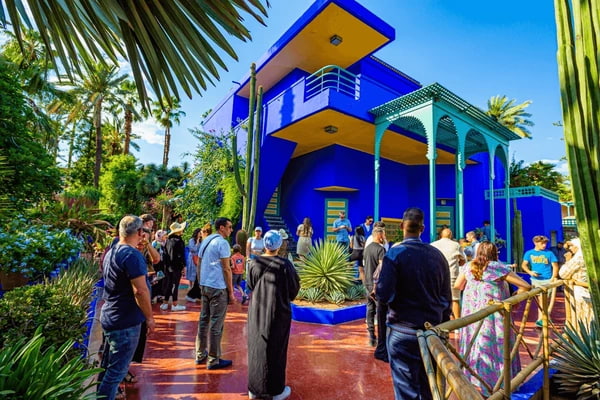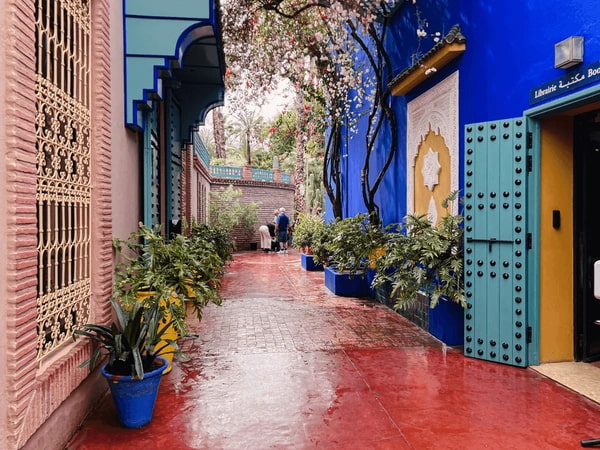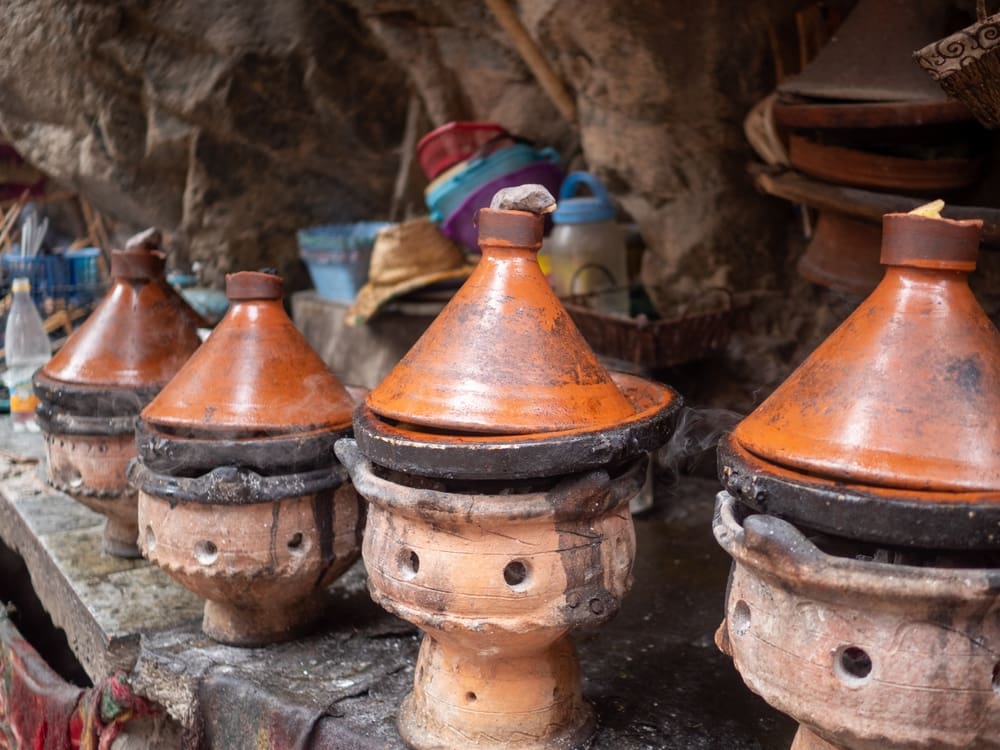Jardin Majorelle, located in the heart of Marrakech, is a famous and vibrant garden created by the French artist Jacques Majorelle. It’s known for its striking blue buildings, beautiful pathways, and lush greenery. Visitors from around the world come to see the vibrant mix of colors and to experience the peaceful escape from the busy city. This garden is like a living painting, filled with exotic plants, winding paths, and small ponds with water lilies.
Originally, Jacques Majorelle designed this garden in the 1920s, inspired by his travels across North Africa. Over time, Jardin Majorelle grew into a botanical haven. Later, the famous French fashion designer Yves Saint Laurent and his partner Pierre Bergé restored the garden, adding their touch to its beauty and preserving it for future generations. Today, visitors can explore not only the gardens but also museums that celebrate Moroccan culture, such as the Berber Museum, which displays artifacts from the Amazigh (Berber) people.
A visit to Jardin Majorelle offers more than just plants and flowers. It’s a chance to see art, culture, and history blended in one place. The design of the garden includes influences from Moorish and Art Deco styles, creating a unique and fascinating atmosphere. To make the most of your visit, it’s helpful to know the best time to go, the garden’s history, and other details like entry fees and nearby places to eat.
Table of Contents
When to Visit Jardin Majorelle

The best time to visit Jardin Majorelle depends on both the weather and how busy the garden can get. Marrakech can be very hot, especially in summer, so planning around the seasons is important. For a comfortable visit, choosing the right season and time of day can make a big difference.
Autumn and spring are the most popular seasons to explore Jardin Majorelle. During these times, the temperature is cooler, making it pleasant to walk around the gardens. Winter is also a good season if you prefer a quieter experience. Summers can be hot, with temperatures often reaching above 100°F (38°C), which may make walking in the sun uncomfortable. However, mornings and late afternoons are usually cooler and less crowded.
Here are some tips for timing your visit:
Best Seasons
- Spring (March to May): Flowers bloom, weather is mild, and gardens are colorful.
- Autumn (September to November): Mild temperatures, fewer crowds, perfect for photos.
- Winter (December to February): Quieter with cool weather, but fewer blooms.
Recommended Times of Day
- Early Morning: Less crowded, especially just after the garden opens.
- Late Afternoon: Cooler with softer lighting, ideal for photos.
Avoid Peak Hours
- Midday can be very crowded. Visiting early or later in the day offers a calmer experience.
Considering these tips can help you enjoy the peaceful beauty of Jardin Majorelle to the fullest. Next, we’ll dive into the history of this unique garden and how it became the treasure it is today.
History of Jardin Majorelle
The story of Jardin Majorelle begins with Jacques Majorelle, a French painter who arrived in Marrakech in the 1920s. Inspired by the colors, landscapes, and cultures of Morocco, Majorelle dreamed of creating a peaceful garden that would also serve as a studio. Over many years, he carefully designed this garden as a place full of unique plants, shaded paths, and fountains. Today, his creation is a popular destination, known worldwide for its beauty and calm.
After Jacques Majorelle’s passing, the garden slowly fell into neglect. However, in the 1980s, the garden was rescued by the famous French fashion designer Yves Saint Laurent and his partner, Pierre Bergé. Together, they restored the garden to its former charm, ensuring it would be open to the public and protected for future generations. This effort not only saved the garden but also turned it into a place of cultural and artistic significance.
Here’s a quick look at important moments in the garden’s history:
- 1920s: Jacques Majorelle begins designing and planting the garden.
- 1947: The garden opens to the public for the first time.
- 1962: Jacques Majorelle passes away, and the garden is gradually abandoned.
- 1980: Yves Saint Laurent and Pierre Bergé buy and restore the garden.
- 2008: After Saint Laurent’s death, a memorial is created in the garden in his honor.
The history of Jardin Majorelle is not only about plants and design but also about the dedication to preserving art and nature. Now, let’s explore the unique design and architecture that make this garden so memorable.
Design and Architecture of Jardin Majorelle

The design and architecture of Jardin Majorelle are as captivating as the plants themselves. Jacques Majorelle, who was also a painter, brought his love for color into the garden’s design. The most famous shade, known as “Majorelle Blue,” covers many of the garden’s walls, fountains, and structures, making them stand out brilliantly against the green of the plants and the warm Moroccan light.
Majorelle designed the garden with inspiration from both Moroccan and Moorish styles. The buildings have a unique look, blending local influences with a touch of European Art Deco style. One of the most striking structures is the cubist villa, originally Majorelle’s studio, where he would paint surrounded by the beauty of his garden.
Key elements of Jardin Majorelle’s design:
Majorelle Blue: A bold, vivid blue that’s almost everywhere in the garden. It contrasts beautifully with the plants and sky.
Cubist Villa: Majorelle’s art studio, now part of the garden’s main attractions, showcases Art Deco and Moroccan design.
Ponds and Water Features: Water lilies float in small ponds, adding a calming effect to the garden. Fountains bring a gentle sound of flowing water.
Paths and Arches: Winding pathways, shaded by palms and banana trees, invite visitors to explore hidden corners and enjoy peaceful spots.
The design captures the magic of Morocco, combining colors, water, and plants in a way that feels both artistic and natural. In the next section, we’ll look at the gardens and museums inside Jardin Majorelle that make this place a must-visit in Marrakech.
Gardens and Museums at Jardin Majorelle
Jardin Majorelle is not just a garden; it’s also home to fascinating museums and a variety of plant species. Walking through this space feels like exploring an open-air gallery, surrounded by carefully chosen plants and art. Each section of the garden and its museums showcases Moroccan culture and history, giving visitors a unique experience.
The garden is filled with botanical treasures. Over 300 types of plants are found here, from cacti and palm trees to banana plants. Water lilies float on small ponds, and tall bamboo creates shady paths. The peaceful layout allows visitors to wander, relax, and enjoy the vibrant colors and scents of nature.
Museums within Jardin Majorelle:
Berber Museum: This museum, housed in Majorelle’s old studio, celebrates the rich culture of the Berber (Amazigh) people of North Africa. Inside, visitors can see traditional Berber jewelry, textiles, and tools, which reveal the unique customs of this indigenous group.
Islamic Art Museum: Featuring an array of artifacts, this museum displays Moroccan art, ceramics, and textiles. It provides insights into the diverse art forms of Islamic culture, connecting visitors to the traditions of North Africa.
Yves Saint Laurent Memorial: The garden includes a tribute to the fashion designer Yves Saint Laurent, who helped restore this oasis. A memorial stone honors his contributions to the garden and his passion for Morocco.
Together, these gardens and museums make Jardin Majorelle an inspiring destination where art, history, and nature blend beautifully.
Cost and Ticket Information
Planning a visit to Jardin Majorelle requires knowing the ticket prices and admission details. Different ticket options are available depending on what visitors want to see. Prices can vary based on age and the areas you plan to visit, including the garden, the museums, or both.
To help visitors choose, here’s a breakdown of the main ticket options:
Garden Entry Only: Provides access to the main garden area where visitors can explore the lush pathways and enjoy the outdoor scenery.
- Adults: Approximately 120 Moroccan dirhams (MAD)
- Children (under 12): Complimentary admission
Garden and Museums Combo Ticket: Includes entrance to the garden, the Berber Museum, and the Islamic Art Museum. This option offers the most complete experience of Jardin Majorelle.
- Adults: Around 200 MAD
- Students (with ID): Reduced rates available
- Children (under 12): Free entry with adult supervision
Where to Buy Tickets:
- On-site: Tickets can be purchased at the entrance, but it’s recommended to arrive early to avoid long lines.
- Online: Visitors can buy tickets in advance from the official website. This is a convenient option, especially during peak seasons.
Additional Tips:
- Last Entry: The garden usually closes in the early evening, so check the schedule for last entry times.
- Photo Policy: While photography is allowed in the garden, it may be restricted in certain museum areas.
- Re-entry Policy: Tickets are generally valid for a single entry, so plan to see everything during one visit.
Knowing the ticket options and planning can make your visit smoother.
Where to Stay Near Jardin Majorelle
Choosing the right place to stay can make a visit to Jardin Majorelle even more enjoyable. Marrakech offers a range of accommodation options, from luxurious hotels to traditional Moroccan riads. Staying nearby allows visitors to experience the garden early in the morning or late in the afternoon when it’s less crowded.
Here are some recommended places to stay near Jardin Majorelle:
La Mamounia Hotel
- This historic and luxurious hotel offers elegant rooms and top-notch amenities. Known for its beautiful gardens and spa, La Mamounia provides a relaxing retreat with a blend of Moroccan and European styles.
- Located about a 10-minute drive from Jardin Majorelle, it’s close enough for easy visits but far enough for a quiet stay.
Riad El Fenn
- A riad is a traditional Moroccan home or palace with an interior garden. Riad El Fenn is popular for its artistic decor and rooftop views of Marrakech. It combines local charm with modern comfort.
- Positioned within walking distance from Jardin Majorelle, it offers easy access to the garden and other city sights.
Four Seasons Resort Marrakech
- This modern hotel has spacious rooms, gardens, and multiple pools. It’s perfect for families or those looking for a resort experience with a touch of luxury.
- Located about a 15-minute drive from the garden, it provides a peaceful escape with excellent service.
Tips for Choosing Accommodation:
- Proximity to Attractions: Staying near Jardin Majorelle and the Marrakech medina can make sightseeing easier.
- Amenities and Services: Check if your hotel offers services like airport transfers, guided tours, or on-site dining.
- Budget-Friendly Options: For those seeking affordable stays, there are many smaller riads and guesthouses in the city center.
With so many choices, visitors can find the perfect spot to rest and recharge.
Where to Eat Near Jardin Majorelle

After a visit to Jardin Majorelle, enjoying a meal at a nearby restaurant can add to the experience. The area around the garden offers various dining options, from traditional Moroccan dishes to modern cafes. These places allow visitors to relax and try local flavors, making the visit to Marrakech even more memorable.
Here are some popular dining spots close to Jardin Majorelle:
Café Bousafsaf
- Located within Jardin Majorelle, this café offers a peaceful setting with views of the garden. The menu includes light meals like salads, sandwiches, and pastries, along with Moroccan mint tea and coffee.
- Ideal for a quick bite after exploring the garden, it provides a cozy place to rest without leaving the site.
Al Fassia
- Known for its authentic Moroccan cuisine, Al Fassia is a popular spot for both locals and tourists. The restaurant is run by women, which is unique in Marrakech and is famous for dishes like tagine, couscous, and pastilla (a sweet and savory pastry).
- Located about 10 minutes from Jardin Majorelle, it offers a warm and traditional dining experience.
Le Jardin
- This restaurant, located in the heart of Marrakech’s medina, is a favorite for its stylish decor and blend of Moroccan and European dishes. Set in a courtyard, it’s perfect for a relaxed lunch or dinner.
- Around 15 minutes from the garden, Le Jardin offers a great mix of flavors and a charming atmosphere.
Tips for Dining Near Jardin Majorelle:
- Try Traditional Dishes: Moroccan specialties like lamb tagine, harira soup, and mint tea are must-tries.
- Make Reservations: Some popular spots can get busy, especially in peak tourist seasons.
- Bring Cash: While some places accept cards, it’s helpful to have cash for smaller cafes.
Whether you’re looking for a quick snack or a full meal, these nearby spots make it easy to enjoy the delicious taste of Morocco. Now, let’s explore other attractions and activities close to Jardin Majorelle.
Activities and Attractions Near Jardin Majorelle
Visiting Jardin Majorelle is just the start of exploring the rich sights of Marrakech. This vibrant city is filled with attractions and activities close to the garden, giving visitors a chance to experience the culture, history, and unique atmosphere of Morocco. After a peaceful time at Jardin Majorelle, visitors can dive into the bustling life of Marrakech’s Medina, explore historical landmarks, or unwind at a local hammam.
Here are some top activities and sights nearby:
Marrakech Medina
- The medina, or old city, is a maze of narrow alleys, colorful souks (markets), and historic buildings. Here, visitors can shop for Moroccan rugs, jewelry, and spices while enjoying the lively atmosphere.
- Located about 10 minutes away, it’s perfect for an afternoon of exploring local crafts and culture.
Koutoubia Mosque
- The Koutoubia Mosque is the largest mosque in Marrakech and a famous landmark. Although non-Muslims cannot enter, the outside and gardens are stunning and make for a peaceful walk.
- A 15-minute drive from Jardin Majorelle, it offers a glimpse into the city’s religious and architectural heritage.
Bahia Palace
- This 19th-century palace is known for its intricate tilework, beautiful gardens, and spacious courtyards. It’s an example of Moroccan architecture and design at its finest.
- About 20 minutes away, the palace is a must-see for history and art lovers.
Traditional Hammam
- A visit to a hammam, or Moroccan bathhouse, is a relaxing way to experience local traditions. Many spas offer hammam services where visitors can enjoy a steam bath and scrub.
- Various hammams are located nearby, providing an authentic and refreshing experience after sightseeing.
Tips for Exploring Nearby Attractions:
- Wear Comfortable Shoes: Many areas, especially the medina, involve walking.
- Plan for Bargaining in Souks: Haggling is common in markets, so don’t hesitate to negotiate prices.
- Respect Local Customs: Modest clothing is recommended, especially when visiting religious sites.
Exploring these nearby spots adds depth to a visit to Jardin Majorelle, combining relaxation with cultural discovery.
Practical Tips for Visitors
Visiting Jardin Majorelle is a memorable experience, but a little preparation can make the day even more enjoyable. With the right tips, visitors can navigate the garden smoothly and avoid common challenges like crowds and heat. From what to wear to the best times to go, here are some practical suggestions to ensure a smooth visit.
Visitor Tips for a Comfortable Experience:
- Wear Comfortable Shoes: The garden has winding paths and plenty of walking areas, so it’s best to wear sturdy shoes to stay comfortable throughout the visit.
- Dress for the Weather: Marrakech can get hot, especially in summer. Lightweight, breathable clothing is ideal, but remember that mornings and evenings can be cooler. Bringing a light jacket in winter can be helpful.
- Plan for Shade and Sun Protection: Jardin Majorelle has shaded spots, but some areas are in full sun. Bring a hat, sunglasses, and sunscreen to protect yourself during the visit.
- Photography Etiquette: While photography is allowed in most areas of the garden, be mindful of other visitors and avoid blocking pathways. Some museums may have restrictions on photography.
- Visit During Off-Peak Hours: Early mornings and late afternoons are less crowded and offer the best lighting for photos. This timing also makes it easier to appreciate the peaceful atmosphere without the hustle of larger crowds.
- Cash and Ticketing: If you plan to buy tickets on-site, it’s helpful to have cash as some places may not accept credit cards. Buying tickets online is also an option to save time.
- Stay Hydrated: Marrakech’s climate can be dry, so bring a water bottle or purchase drinks at Café Bousafsaf inside the garden.
Following these tips can help visitors fully enjoy the charm of Jardin Majorelle.
Conclusion
Jardin Majorelle is a unique blend of art, culture, and nature, making it a must-visit location for anyone traveling to Marrakech. The garden’s lush landscapes, vibrant colors, and tranquil atmosphere offer a refreshing escape from the city’s busy streets. Each corner of the garden has been thoughtfully designed, from the bright blue buildings to the peaceful ponds, creating a visually stunning experience for visitors.
More than just a garden, Jardin Majorelle houses rich cultural exhibits, including the Berber Museum and the Islamic Art Museum. These museums add a deeper layer to the visit, allowing people to learn about the history, art, and traditions of Morocco and North Africa. Thanks to Yves Saint Laurent’s dedication to preserving this beautiful space, Jardin Majorelle continues to inspire and educate people from all over the world.
A visit to Jardin Majorelle can be a memorable part of any Marrakech trip. By planning carefully, visitors can enjoy the beauty of the garden while also exploring nearby attractions, savoring local cuisine, and discovering the vibrant life of Marrakech. Whether you’re a nature lover, art enthusiast, or history fan, Jardin Majorelle offers something special for everyone.
FAQs
Is Jardin Majorelle accessible for people with disabilities?
Yes, Jardin Majorelle has paths that are wheelchair-friendly, but some areas may have limited access.
How much time should I plan to spend at Jardin Majorelle?
Most visitors spend about 1–2 hours exploring the garden and museums.
Can I bring my own food into the garden?
No, outside food and drinks are not allowed, but there is a café inside where visitors can purchase refreshments.
Are pets allowed in Jardin Majorelle?
No, pets are not permitted to ensure the safety and comfort of all visitors.
Is there parking available near the garden?
Yes, there is parking nearby, but spaces can be limited, especially during peak hours.
